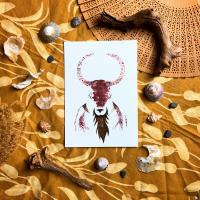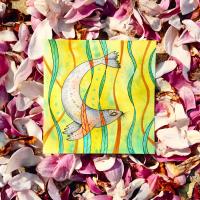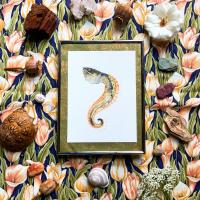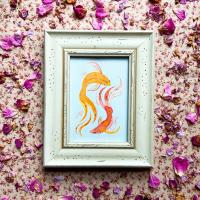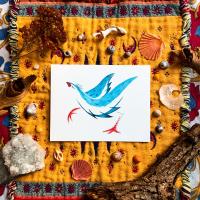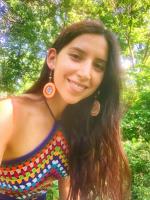Born in Argentina and based in Kansas City, Sol Anzorena imbues her art with a passion for the environment. Sol has studied at the Universidad de Granada in Spain, Uniwersytet Artystyczny w Poznaniu in Poland and Faculdade de Artes Plasticas in Brazil. Her studies abroad and travels through Asia have informed and inspired Sol’s paintings of the natural world.
Introduce yourself and describe your work and the medium you work in.
My name is Sol Anzorena and I’m a visual artist, muralist, photographer and musician born in Argentina and raised in Spain, now living in Kansas City. For my art practice I only use materials that don’t pollute the planet or unnecessarily harm its lifeforms, like non-toxic paints, watercolor paper obtained from sustainable sources and art tools that don’t contain animal ingredients, and I collect all my frames from thrift stores or second-hand sources in order not to contribute to consumerism. I cover a variety of topics, but they all emerge from my admiration of nature. I believe that how you create a piece of art is just as important as the final result. To me, it doesn’t matter how expensive and high-quality your materials are if they contain heavy chemicals and create a lot of waste – I am much more impressed by someone who consciously chooses their resources. To make beautiful art, we must never threaten the far greater beauty of the earth.
How does your work address environmental problems?
There are many ways to address environmental problems through art. I use to create paintings that showed animals suffering and suffocating in their contaminated habitats, but even though these pieces made a big impression on people, I began to feel increasingly aware of the fact that the process was not consistent with the message. So I reevaluated my philosophy, and now I believe that the point is not just to make a nice thing to hang on the wall, but to make art which was conscious and compassionate every step of the way. Taking the time to repair something that already exists instead of consuming something new that eventually will end up in a landfill can be even more impactful than the content itself, because it shows people new possibilities. I wanted to demonstrate that I would be able to make a whole exhibition only using these eco-friendly materials and upcycled frames, and for my last exhibition at the George Schlegel Gallery I was able to display over 30 paintings on this manner.
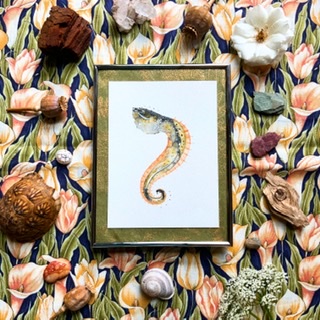
How have your travels influenced your work?
I think that traveling so much is what has given so many dimensions to my art. During my first couple of years studying at the University of Granada in Spain, I was exposed to many different techniques, but now looking back at the pieces that I made during that time, I notice a lack of real meaning in them. My most interesting pieces appeared during the summers, when my partner and I took our backpacks and travelled to other countries, and I felt free to express myself outside of the classroom. Being in these diverse, sometimes challenging environments and with very limited supplies, I started to find out what topics really mattered to me.
I spent a year studying in Poland, and this was a very transformative period. I got rid of all colors in my palette and just worked with black and white, inspired by the local art and history of this country. My works had great detail, and I dedicated the full year to a series of works called Red Ocean, Black Earth, in which I addressed environmental concerns and the abuse of animal rights. Learning about the exploitation of all sorts of animals and their habitats brought a lot of sadness and a feeling of despair to me. Somehow I felt like I was the only person trying to do something and failing due to the magnitude of my opponent — civilization’s unconscious quest for “progress” despite the costs.
I spent another year in Salvador de Bahia, Brazil. In that vibrant country my work experienced an explosion of color and liveliness. I started to channel my energy to "solve" all the world’s problems into practical actions, like putting little reminders for my classmates and professors to bring their own cups instead of using disposable plastic ones. It might seem like a trivial step, but eventually I got noticed by the director of the department and more changes started to take place.
My last big trip was to India and Nepal, where my partner and I decided not to bring cameras, laptops, phones or technology of any kind. The idea was to connect to a deeper level with the locals, with the environment and with ourselves. The only thing I brought with me was a sketchbook and some watercolors. With no distractions, I begin to feel much more present in the creation of art, as though it were a meditation. This was one of the most revolutionary times for me, not just creatively but spiritually, and I would encourage everyone to see what it’s like to spend just a day without screens and gadgets.
For the last year I’ve been working on a series of minimalist paintings of animals here in the US. I’m creating something like a ritual in which I empty my mind of thoughts and start finding shapes on splashes of watercolor paint, combining randomness with intention. I don’t have any idea of what I will end up painting. I just let the water and my intuition guide me. I love creating microcosms in these little splashes of paint and teasing out the faces, legs, paws, beaks, tails and wings from my characters with just a few lines. I take a long time preparing my mind before starting to paint, because I need to be very precise but also very loose when I make the brush strokes, so that I can let myself be guided by what’s happening with the water and pigments. I also enjoy not being so much "in control" of the situation because, after all, the water will do whatever it wants!
One thing that really changed my life was learning about ScrapsKC. This is an amazing shop where people donate different textiles, tools, and art supplies that they don’t need anymore. There I can find color pencils, charcoal and even some half used tubes of watercolors. Recently I’ve spent a lot of time collecting second-hand fabrics and embroidery floss to make jewelry and clothing. Creating these wearable pieces has given my art another dimension, since now when somebody wears one of them they know that it was made with a lot of love and care from materials that would have gone to the landfill otherwise. These pieces become a part of them and say to the world "somebody made this with their hands, they cared about our Earth, and I do too."
What do you feel is your role as an artist?
I think that most people believe that artists are people who make "beautiful things." To me beauty is just a side effect from pursuing an idea with all your intention. In a way I feel that I’m an explorer of this infinite language which is art. I’m translating my ideas and feelings into something material, and in that process I’m connecting with people in a more profound level than I could ever do with just words. Words have to pass through your ear, then your brain, and they may or may not ever effect your emotions, but an image can be much more immediate. That is why I have great hope for art in changing not just how we think, but how we feel about Nature and our relationship to it.
I also want to invite other artists to do the same and change their practices so they are more in harmony with the earth. Many artists couldn’t live without creating — it’s what makes us wake up in the morning and have a purpose. That’s why paying more attention to the materials that we use is essential. Art is our everyday practice, it’s our ritual, and it deserves to be treated as something sacred. We shouldn’t want to work with poison but to make an offering to the world and ourselves that is like nourishment to the collective soul.
What is your most important artistic tool? Is there something you can’t live without in your studio?
After having such limited resources in my travels, now I feel I can create art with anything. I don’t get attached to my tools because I’m always open to work with different materials. I’m curious to explore working more with materials that will biodegrade, like flowers, pine cones, leaves, bark, etc. I imagine creating paintings on the ground and watching how they decompose with time. The only thing I always want to have when I create is the intention to enjoy what I’m doing and to do my best.
What books, movies and/or music have inspired you recently?
My partner and I just found this gorgeous book called East of the Sun and West of the Moon, a collection of old Norwegian fairytales with the illustrations from Kay Nielsen, which has inspired me to try a more detailed style again. One of the most remarkable things from Kay’s illustrations are all the rich and colorful patterns in the clothes from the characters that he portrays. Out of drawing simple geometrical forms he created the most elegant and beautiful textures.
Another book which I’m in love with is The Boy, the Mole, the Fox and the Horse, written and illustrated by Charlie Mackesy. The story is really touching, but the illustrations are just mesmerizing. The simplicity in each scene makes you feel like you’re seeing images from a dream. I have great respect for art which communicates so much using so little, which is also why I love the landscape paintings of East Asia: in all of them, a large of the canvas remains empty.
A movie that has been a new discovery for me was The Thief and The Cobbler, directed by Richard Williams. Even though it’s unfinished, all of the scenes are unbelievably beautiful. It’s like going on a trip inside a crazy genius’s brain. Despite being one of the greatest works of American illustration, it’s almost entirely unknown.
As for music, recently I’ve been listening to Adrianne Lenker, Javiera Barreau, Violeta Parra and Phoebe Bridgers. All these amazingly talented women inspire me to compose new songs and try different melodies and lyrics for my band Roadkill Rising.


